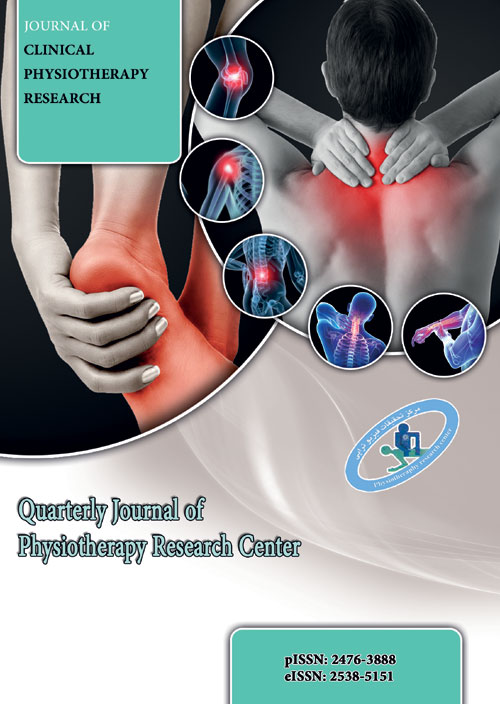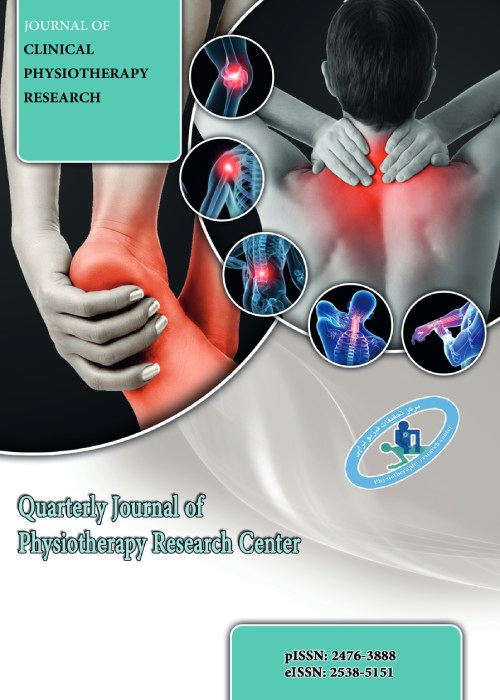فهرست مطالب

Journal of Clinical Physiotherapy Research
Volume:7 Issue: 1, Winter 2022
- تاریخ انتشار: 1401/06/16
- تعداد عناوین: 6
-
-
Page 53Background and Aim
The aim of this study was to present and discuss the knowledge gathered on various Achilles tendon injuries and to highlight the clinical implications for the evaluation and treatment of Achilles tendon injuries. Achilles injury is common in both athletes and non-athletes. Study design: Systematic review.
MethodsA search of 6 databases was performed using keywords related to Achilles tendon injury factors and a review of all usable manuscripts was performed.
ResultOne hundred and fifteen articles met the inclusion criteria. Among all the independent variables that were analyzed, age, obesity, athletes and normal people, professional or amateur sports, men and women, and Achilles tendon treatment methods were examined.
ConclusionComparison of the incidence of Achilles tendon injuries in sports and non-sports shows that the increased risk of Achilles tendon injuries in male athletes is higher than women, which has the opposite effect with age, and it can be concluded that Achilles injuries in both Men and women are generally almost equal.
Keywords: Achilles -
Page 54Introduction and Objectives
Jumping and landing is a fundamental and very important component in the implementation of defense techniques on the net, jumping service and spike. The skill of defending on the net, spike (strength or speed) is one of the most important predictors of success during volleyball matches, and also the level of rigidity will affect the injuries because a change in the amount of this parameter will increase the applied forces.
Materials and MethodsThe present study is quasi-experimental, causal-comparative model and applied. The statistical population was 14 volleyball players aged 18 to 20 years. The electrical activity of the muscles was recorded by an 8-channel biod electromyography device based on the SENIAM protocol on 4 selected lower limb muscles.
ResultsFrom the mean and standard deviation for data description, Shapirovilk for evaluating the normality of data distribution, inferential statistics for the effect of surface type on research variables from analysis of variance test with repeated measures and for differences from Bonferren post hoc test was used.
ConclusionThere is no significant difference between peak muscle activity in external extensor muscles and biceps when jumping and landing on tatami, grass and sand (p≤0.05), but in anterior and twin buttock muscle function between Significant differences were observed at different levels (p = 0.00). Based on the results of Bonferroni post hoc test, in the function of the anterior buttock muscle, only a significant difference in muscle function was seen between the tatami and grass surfaces (p≥0.05). Similarly, in twin muscle, there was a significant difference between tatami and sand levels (p = 0.00), tatami and grass (p = 0.00) (Table 2). Also, there was no significant difference between the co-contractile function in the knee joint (p≤0.05), although the mean percentage of co-contraction on the grass was the highest average and on the sand was the lowest average. There was no significant difference in the ankle joint (p≤0.05), similarly, the lowest mean was related to the contraction of the ankle joint on the sand, but the highest mean was seen when jumping on the tatami.
Keywords: different levels, jump-landing, electromyography, pick contraction, selected lower limb muscles -
Page 56Background and Aims
Regular exercise and physical activity is one way to promote health and prevent physical and mental diseases. The aim of this study was to investigate the effect of endurance training on positive and negative slopes (ETPS and ETNS) (±15°) on the biomechanical properties of the femur in male Wistar rats.
Materials and MethodsThis experimental study was performed on 15 male Wistar rats with an approximate age of eight weeks and a weight range of 20-180 g. For this purpose, the rats were divided into 3 groups, namely the control group (without activity), the ETPS group and the ETNS group. The endurance training (ET) program was performed 5 days a week for 8 weeks.
ResultsSignificant improvement in biomechanical variables (maximum force, strength, deformation and maximum absorbed energy) of the femur was observed in the ETPS group compared with the other two groups. However, the ETNS reduced all biomechanical variables of the femur.
ConclusionThe results indicate that ETPS is effective in improving the bone indices. Given the significant difference between the ETPS and ETNS groups in the biomechanical parameters of the bone, a training program with different intensity and duration levels in other age groups in different slopes is suggested.
Keywords: ndurance Training, Biomechanical testing, Femur bone, Three-point bending, Animal mode -
Page 57Introduction & Objective
Plantar pressure is acted between the foot and the support surface during everyday locomotor activities. Information derived from plantar pressure distribution symmetry is important in gait and posture research for diagnosing lower limb problems, footwear design, injury prevention and other applications. Hence, this paper was aimed to review plantar pressure distribution symmetry in adolescence girls with genu varum, genu valgum and healthy during gait.
Materials and MethodsThe research was quasi-experimental, causal-comparative and applied research model. Subjects included 45 girls with genu valgum, genu varum and healthy girls. The plantar pressure values were examined in 10 anatomical areas of plantar pressure on 0, ±10% slopes in the gait stance phase. Two-way analysis of variance with repeated measures was used for statistical analysis. Significance level was equal to 0.05.
FindingsNo significant difference was observed in the symmetry variables of plantar pressure distribution in 0, ±10 slopes in the genu varum, genu valgum and healthy groups. While the healthy group at the 1,5 metatarsus and tarsus on the slope (surface slope) and the 5th metatarsus on -10% slope, and genu varum group at maximum tarsus pressure in all three levels and maximum tarsal 2-5 pressure only on the slope and maximum plantar pressure on the 10% slope and the maximum 1st plantar pressure on -10% slope for the genu valgum group have better symmetry.
ConclusionThe results show that genu varum and genu valgum anomalies affect the symmetry indices of plantar pressure distribution in adolescent girls; so that adolescent girls with knee deformities have less symmetry in the 5th metatarsus and tarsal 2-5 than healthy people. Therefore, the slope (surface slope) can be suggested to improve the plantar pressure distribution pattern in adolescent girls with genu varum and genu valgum knees. However, more studies are needed in this area.
Keywords: Symmetry, Plantar pressure distribution, Genu valgum, Genu varum, Slope, Gait, Adolescent Girls -
Page 58Background and Aims
Although it is documented that cardiac rehabilitation has a positive effect on hemodynamics and functional biomechanics of the heart, but the effect of various exercises in this area, in different periods of life such as middle age and older male adults, after the onset of coronary artery disease followed The cardiac event or therapeutic interventions are thought-provoking. The aim of the present study was to compare eight weeks of cardiac rehabilitation training on selected hemodynamic and biomechanical indices between middle-aged and elderly men with coronary artery disease following a cardiac event or therapeutic interventions.
Materials and MethodsIn this quasi-experimental study, pre- and post-test research design, impact assessment model (causal-comparative) and in terms of application type, 32 middle-aged men (16 people) and older male adults (16 people) with vascular disease The coronary arteries, each randomly and evenly, were divided into two groups of aerobic and concurrent exercises. Subjects obtained a certificate from a cardiologist to participate in the study, were introduced to the imaging center (echo Doppler) and exercise test for the pre-test. Subsequently, before and after eight weeks of cardiac rehabilitation training, the test was performed in the biomechanics laboratory of the physical medicine center. To analyze the data from mean and standard deviation, from Shapiro-Wilk test to check the normal distribution, from Leven test to determine the homogeneity of variance of groups, and from one-way analysis of variance with bonferroni post hoc test to check Differences between groups were used at the level of significance (p ≤0/05).
ResultsAfter eight weeks of aerobic exercise, a significant difference in the improvement of resting metabolism and diastolic blood pressure indices was observed between the two exercise groups between middle-aged and older male adults (p ≤0/05), but there was a significant difference in discharge fraction indices). Left ventricle, resting heart rate and systolic blood pressure were not observed (p > 0/05). After concurrent training, there was a significant difference in improving the indicators of resting metabolism, left ventricular ejection fraction, resting heart rate and blood pressure. Diastolic was observed between the middle-aged and older male adults exercise groups (p ≤0/05), but no significant difference was observed in systolic blood pressure index (p > 0/05).
ConclusionThe results of the study confirmed the effectiveness of both aerobic and parallel exercise in improving hemodynamic and biomechanical indicators of cardiac function. In comparison between the elderly and middle-aged people, the effect of aerobic exercise in the elderly and the effect of parallel exercise in the middle He considered the year more prominent. It seems that the priority of using parallel exercise over aerobic exercise can be considered.
Keywords: Exercise, cardiac complication, biomechanics of heart function, coronary artery disease -
Page 59Introduction
Children with attention-deficit/hyperactivity disorder face many psychological and social problems. This study aimed to investigate the effect of aerobic exercise on the components of psychological well-being of children with attention-deficit/hyperactivity disorder.
Materials and MethodThe research design was quasi-experimental. Thirty children were randomly selected from children with attention-deficit/hyperactivity disorder in Qom and were divided into experimental and control groups (15 experimental and 15 control). Aerobic exercise training was performed on the experimental group for eight weeks, three sessions per week for 45 minutes. Data analysis was performed using multivariate analysis of covariance using SPSS-22 software.
ResultsThe results showed that the psychological well-being scores for the experimental group increased significantly compared to the control group. Aerobic exercise promotes the components of psychological well-being (self-acceptance, positive relationships with others, independence, mastery of the environment, purposeful life, and personal growth) of the children in the experimental group.
ConclusionAerobic exercise seems to be a suitable treatment strategy without side effects to improve and enhance the psychological well-being of children with attention-deficit/hyperactivity disorder. This finding emphasizes the need for physical activity.
Keywords: Aerobics, Psychological well-being, Attention-deficit hyperactivity disorder


